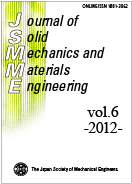Volume 6, Issue 8
Displaying 1-5 of 5 articles from this issue
- |<
- <
- 1
- >
- >|
Papers
-
2012Volume 6Issue 8 Pages 871-885
Published: 2012
Released on J-STAGE: August 31, 2012
Download PDF (784K) -
2012Volume 6Issue 8 Pages 886-899
Published: 2012
Released on J-STAGE: August 31, 2012
Download PDF (481K) -
Genetic Algorithm Optimization for Additional Tensioning in Rotating Circular Saw under Thermal Load2012Volume 6Issue 8 Pages 900-912
Published: 2012
Released on J-STAGE: August 31, 2012
Download PDF (2047K) -
2012Volume 6Issue 8 Pages 913-924
Published: 2012
Released on J-STAGE: August 31, 2012
Download PDF (1013K) -
2012Volume 6Issue 8 Pages 925-934
Published: 2012
Released on J-STAGE: August 31, 2012
Download PDF (552K)
- |<
- <
- 1
- >
- >|
